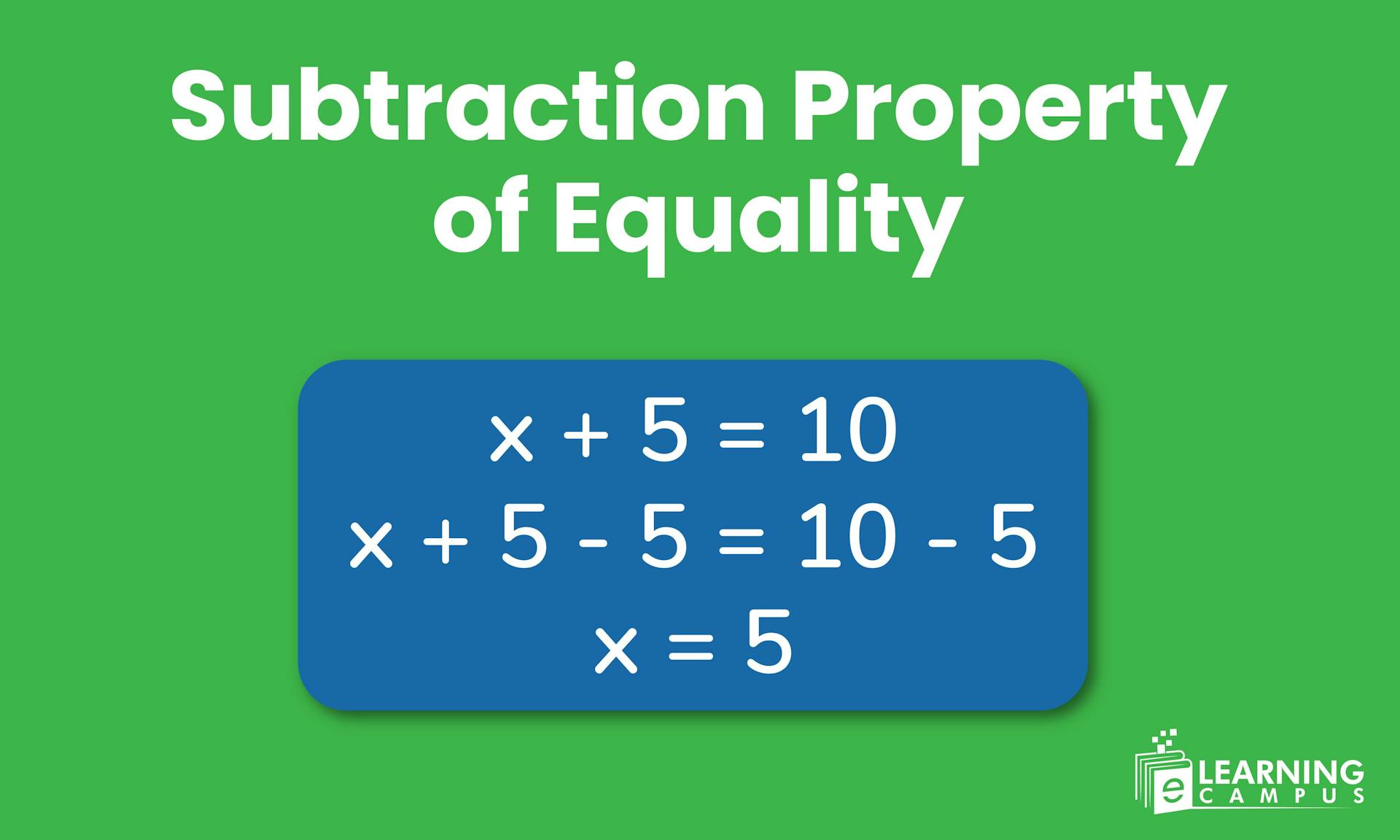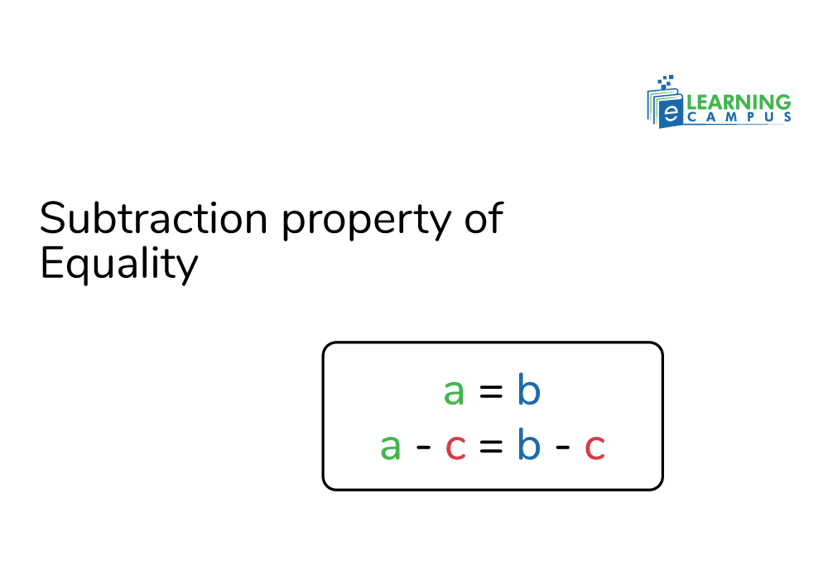Subtraction Property of Equality

Have you ever struggled to balance equations while solving complex problems? And you don’t have a clue what keeps both sides of an equation perfectly aligned? The answer lies in a fundamental principle of algebra: the Subtraction Property of Equality.
This rule ensures that equations remain true by allowing us to subtract the same value from both sides without disrupting their balance.
In this blog, you will learn the definition of the subtraction property of equality in math with an example, explore its role in solving equations, and discover why it is important for mathematical reasoning.
What is the Subtraction Property of Equality
The subtraction property of equality states that ‘the subtraction of the same quantity from both sides of an equation keeps the equation balanced.’
This principle helps to solve equations for an unknown variable by simplifying the equation by keeping it balanced, as we isolate the variable.
In simple terms, if we subtract a number from one side of the equation, then we must subtract the same number from the other side of the equation to keep it balanced.
We will understand it with the help of an example.
Let’s consider two equal equations, x and y. If we subtract ‘z’ from both equations x and y, then the difference of x and z will be equal to the difference of y and z.
Mathematically, we can write it as;
Subtraction Property of Equality Formula
The subtraction property of the equality formula represents that if we subtract the same number from both sides of an equation, the equality is maintained. For two equal equations a and b, the formula of the subtraction property of equality is represented as;

Subtraction Property of Equality Example
We can understand this property of subtraction with the help of examples. Here are solved examples.
Example 1
If we subtract 7 from both sides of the equation, then the equation should maintain equality.
Example 2
We will subtract 5 from both sides.
- If the variable is on the right side of the equation
Sometimes a variable 𝑥 appears on the right side of the equation. For example,
We will add 8 on both sides
- If an equation has more than one variable
If there is more than one variable in an equation, we need to simplify one or both sides of the equation before using the subtraction property of equality.
Example
Combine like terms of the equation.
Subtract 3 from each side of the equation.
Verification of Subtraction Property of Equality
As we learned about the property of equality of subtraction, we can verify it with the help of an example. To verify the subtraction property of equality, we substitute the solution into the original equation and check if both sides are equal.
This is done by simplifying the equation after substituting the value for the variable, demonstrating that subtracting the same number from both sides maintains the equality of the equation.
Step-by-step verification
- Solve the equation: Use the subtraction property of equality to find the value of the variable.
- Substitute the solution: Replace the variable in the original equation with the value you found.
- Simplify both sides: Perform the operations on each side of the equation.
- Check for equality: Compare the results of both sides. If both sides are equal, the solution is correct, and you have verified the property.
Example
Solve x+6=12
To solve this equation, we will subtract 6 from both sides.
To verify this solution, we will replace the value of the variable in the original equation, which is
Replace x with 6
Both sides are equal. So, the property is proved.
Subtraction Property of Equality for Fractions
The Subtraction Property of Equality for fractions states that if you have two equal fractions, subtracting the same fraction from both sides results in equal differences.
If two fractions are the same, i.e
$$\frac{a}{b} = \frac{y}{z}$$
then subtracting the same fraction
$$\frac{c}{d}$$
from both sides keeps the equation equal.
It is represented as;
Solving Equations Involves the Subtraction Property of Equality for Fractions
- Identify the fraction to subtract: To solve for a variable, find the fraction being added to it and use its opposite (subtraction) to cancel it out.
- Subtract from both sides: Subtract the fraction from both sides of the equation to maintain balance.
- Isolate the variable: The fraction you subtracted will be canceled out on the side of the variable, leaving it isolated.
- Solve the remaining equation: Perform the subtraction on the other side of the equation. This may require finding a common denominator if the fractions have different denominators.
Example
Solve for x in the equation
The fraction being added to x is 10/7
Subtract 10/7 from both sides of the equation
107 terms cancel out on the left side, leaving you with just x.
To solve the right side, find a common denominator, which is 21.
Subtraction Property of Equality in Geometry
The Subtraction Property of Equality in geometry states that if two geometric figures or measures are equal, and subtracting the same quantity or figure from both, the resulting differences are also equal.
This property is fundamental to writing geometric proofs and solving for unknown values.
For an angle, the subtraction property of equality states that if equal angle measures are subtracted from equal angle measures, the resulting differences will also be equal. It means that the resulting angles are congruent.
This property is used in proofs to show that if we have two congruent angles and remove (subtract) another congruent angle from each of them, the remaining portions of the original angles will also be congruent.
In simple terms:
- If Angle A is congruent to Angle B (m∠A = m∠B).
- And you subtract Angle C from both of them (m∠A - m∠C = m∠B - m∠C).
- Then, the resulting angles (Angle A minus C, and Angle B minus C) will be congruent to each other.
Conclusion
The Subtraction Property of Equality states that if you subtract the same number from both sides of an equation, the equality remains true. In other words, if a = b, then a-c=b-c for any number c. This property is a key for solving equations, as it allows to isolate the variable by eliminating terms from one side of the equation.
Get Math Help With Expert Online Tutor
Are you struggling with mathematical concepts? We are at your service. We have expert online Tutors to teach you mathematical concepts in an easy way. You will get one-on-one tutoring for exam preparation.
